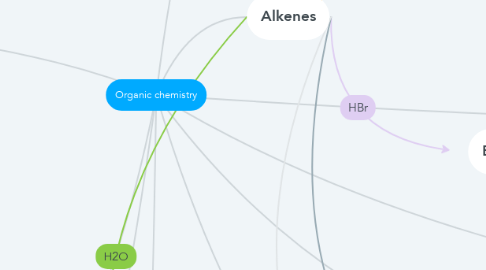Organic chemistry
by Vivian Petinou


1. Reagent: steam
2. Aldehydes
2.1. Reagent: potassium dichromate and dilute sulphuric acid
2.2. Conditions: warm, distillation
2.3. Type of reaction: mild oxidation
2.4. Equation: RCH2OH + [O] --> RCHO + H2O
3. Primary alcohols
4. Alcohols
4.1. Conditions: 300 oC, 60 atm, H3PO4 catalyst
4.2. Type of reaction: electrophilic addition
4.3. CH2=CH2 + H2O -> CH3CH2OH
5. Carboxylic acids
5.1. Reagent: potassium dichromate and dilute sulphuric acid
5.2. Conditions: heat, reflux
5.3. Type of reaction: oxidation
5.4. Equation: CH3CHO + [O] -> CH3COOH
6. Esters
6.1. reaction: esterification
6.2. produces water (condensation)
6.3. conditions: concentrated sulphuric acid
7. Nitriles
8. conditions: RT
9. with inorganic chloride
9.1. CH3CH2OH + SOCL2 ->CH3CH2Cl + SO2 HCl
10. equation: CH3CH=CH2 + Br2 -> CH3CHBrCH2Br
11. reagent: Br2
12. Ketones
12.1. Reagent: potassium dichromate and dilute sulphuric acid
12.2. Conditions: heat, distillation
12.3. Type of reaction: oxidation
12.4. Equation: (CH3)2CH(OH) + [O] --> (CH3)2C=O + H2O
13. Secondary alcohols
14. Polyalkenes
14.1. conditions: low T, high p
14.2. Type of reaction: addition polymerisation (free radical)
15. Dibromoalkanes
15.1. Type of reaction: electrophilic addition
16. Bromoalkanes
16.1. reagent: HBr
16.2. conditions: RT
16.3. Type of reaction: electrophilic addition
16.4. equation: CH2=CHCH3 + HBr -> CH3CHBrCH3
17. Chloroalkanes
17.1. reagents: Cl2
17.2. conditions: UV light
17.3. Type of reaction: free radical substitution
17.4. equation: CH3CH3 + Cl2 --> CH3CH2Cl + HCl
18. Alkanes
19. Alkenes
20. Halogenoalkanes
20.1. Nucleophiles
20.1.1. Water
20.1.1.1. Heat
20.1.1.1.1. CH3CH2OH + HBr
20.1.2. Hydroxide ions
20.1.2.1. Heat with NaOH
20.1.2.1.1. CH3CH2OH + Br ion
20.1.3. Ammonia
20.1.3.1. Heat under pressure in a sealed tube with NH3 in ethanol
20.1.3.1.1. CH3CH2NH2 + HBr
20.1.4. Cyanide ion
20.1.4.1. Heat in ethanol with NaCN
20.1.4.1.1. CH3CH2CN + Br ion
21. Type of bromoalkane
21.1. Primary
21.1.1. SN2
21.2. Secondary
21.2.1. SN1 + SN2
21.3. Tertiary
21.3.1. SN1

